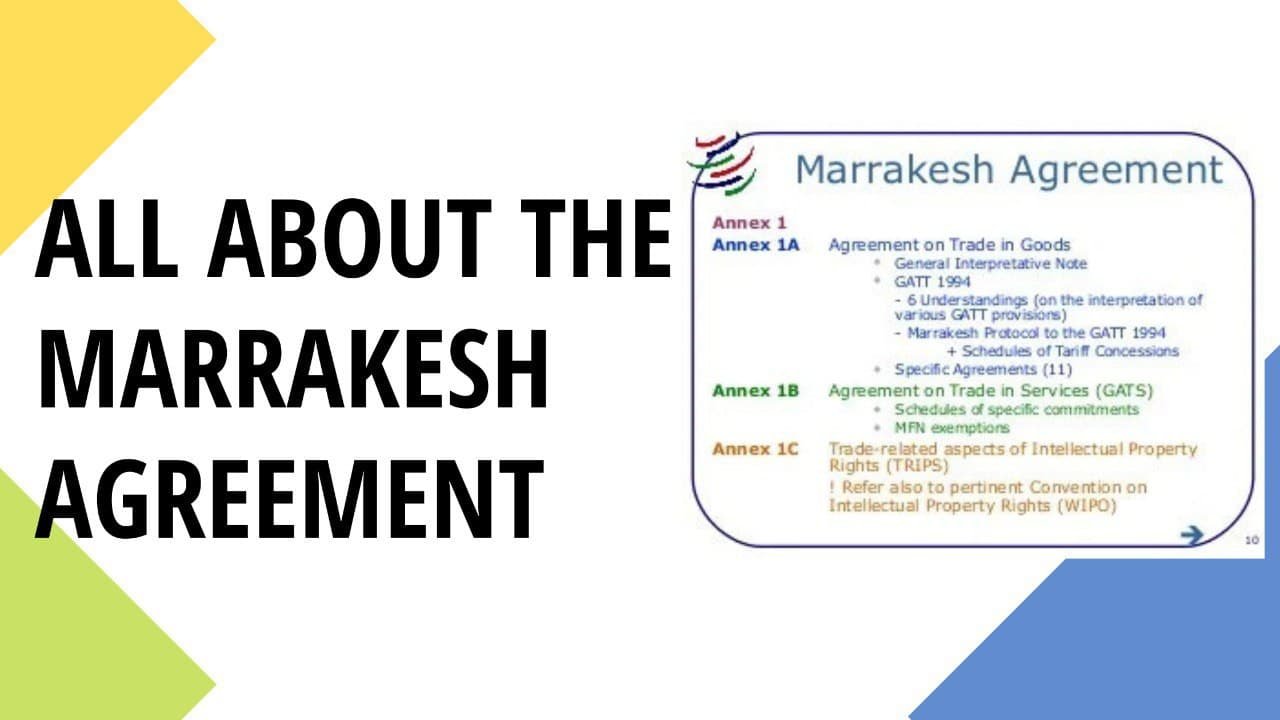ALL ABOUT THE MARRAKESH AGREEMENT
The World Trade Organization Agreement, also known as the Marrakesh Agreement, was signed on April 15, 1994, in Marrakesh, Morocco, following the Uruguay Round of Multilateral Trade Negotiations. This agreement defines the World Trade Organization's scope, functions, and agency. Agreements negotiated previously under the General Agreement on Tariffs and Trade, as well as accords reached during the Uruguay Round, are included in the Marrakesh Agreements annexes. These treaties have now been reclassified as World Trade Organization (WTO) treaties. The Marrakesh Agreement binds all World Trade Organization members, including those who joined after it was signed.

INTRODUCTION
The World Trade Organization Agreement, also known as the Marrakesh Agreement, was signed
on April 15, 1994, in Marrakesh, Morocco, following the Uruguay Round of Multilateral Trade
Negotiations.
This agreement defines the World Trade Organization's scope, functions, and agency.
Agreements negotiated previously under the General Agreement on Tariffs and Trade, as well as
accords reached during the Uruguay Round, are included in the Marrakesh Agreement's annexes.
These treaties have now been reclassified as World Trade Organization (WTO) treaties. The
Marrakesh Agreement binds all World Trade Organization members, including those who joined
after it was signed.
HISTORICAL BACKGROUND OF THE MARRAKESH AGREEMENT
The General Agreement on Tariffs and Trade, abbreviated as GATT 1947, was an agreement
signed in Geneva in 1947 by 23 nations. It went into effect on January 1, 1948, with the primary
goal of phasing out import quotas and lowering tariffs on merchandise trade.
GATT 1947 was the trade agreement that governed international trade from 1948 until the
establishment of a proper international trade organization (World Trade Organization, 1995).
Despite its many problems, which ranged from non-inclusivity of various nations to other
institutional issues, GATT 1947 was able to hold eight rounds of multilateral trade negotiations,
the most recent of which was the Uruguay Round (1986-1994), which resulted in the Marrakesh
Agreement, which established the World Trade Organization.
The Marrakesh Agreement established a new General Agreement on Trade and Tariffs (GATT
1994) (present in Annex 1A of the Agreement).
NEED FOR THE MARRAKESH AGREEMENT
GATT 1947 was a treaty between certain countries, but it was not legally binding. Thus, its
provisions applied to the extent that they were consistent with the laws of the country. The
GATT was also signed between 23 nations, implying that it was not at all inclusive. As more
nations began to participate in GATT-organized trade talks, it became clear that GATT would
serve better if it had an institutional organization to back it up. As a result, during the Uruguay
Rounds, the Marrakesh Agreement was signed, resulting in the formation of an institutional
organization, the WTO.
DISCUSSION OF THE ARTICLES OF THE MARRAKESH AGREEMENT
1. The first part of the agreement, which can be considered to fulfil the objectives of a
standard preamble, explains the primary objectives of the Marrakesh Agreement. It states
that the parties to the Agreement- 1. Recognized that their trade and economic relations should be conducted to raise living standards, ensure full employment, and a large and steadily growing volume of real income and effective demand, and expand production and trade in goods and services, all while allowing for the most efficient use of the worlds resources in accordance with the goal of sustainable development.
2. Recognized the need for positive action for the development of developing and least-
developed countries, so that they, too, can secure a share of the international market that
will benefit their home economy.
3. Were eager to contribute to the aforementioned objectives by entering into reciprocal and
mutually beneficial agreements aimed at significantly lowering tariffs and other trade
barriers, as well as eliminating discriminatory treatment in international commercial
relations.
4. Resolved to construct an interconnected, economically sustainable, and long-lasting
global trade system that incorporates the GATT 1947, previous trade liberalization
efforts, and all of the Uruguay Round Multilateral Trade Negotiations.
5. Were determined to uphold the fundamental principles and further the goals underlying
this multilateral trading system.
IMPLICATIONS OF THE MARRAKESH AGREEMENT
The Marrakesh Agreement created the world's first international trade organization. This resulted
in a much more structured approach to international trade, resulting in greater inclusivity of
various countries in the era of globalization. The establishment of the World Trade Organization
resulted in a rapid expansion of international trade, which accelerated the individual growth of
both member and non-member countries.
The World Trade Organization is a proponent of free trade. While this has facilitated the growth
of various multinational corporations and easy access to low-cost goods around the world, it has
had a negative impact on the home-grown economies of various third-world countries. Many
critics claim that the WTO's free trade campaign has ignored the needs of these countries due to
a lack of trade protection. Another WTO principle is the principle of "most favored nation.
This presupposes that countries must trade without regard for discrimination. While this has been
beneficial in some cases, in most cases, developing countries are barred from favoring their own
companies, which could have aided in the acceleration of development. The WTO also fails to
take adequate account of environmental concerns, which is extremely concerning.
CONCLUSION
By establishing the World Trade Organization, the Marrakesh Agreement was thus responsible
for bridging the gap between developed and developing nations. The World Trade Organization
(WTO) is one of the most important international organizations in the world today, regulating
trade between nearly 164 entities. The organization has grown in importance, particularly as a
result of the creation of a globalized economy.
written by- ANKUSH












